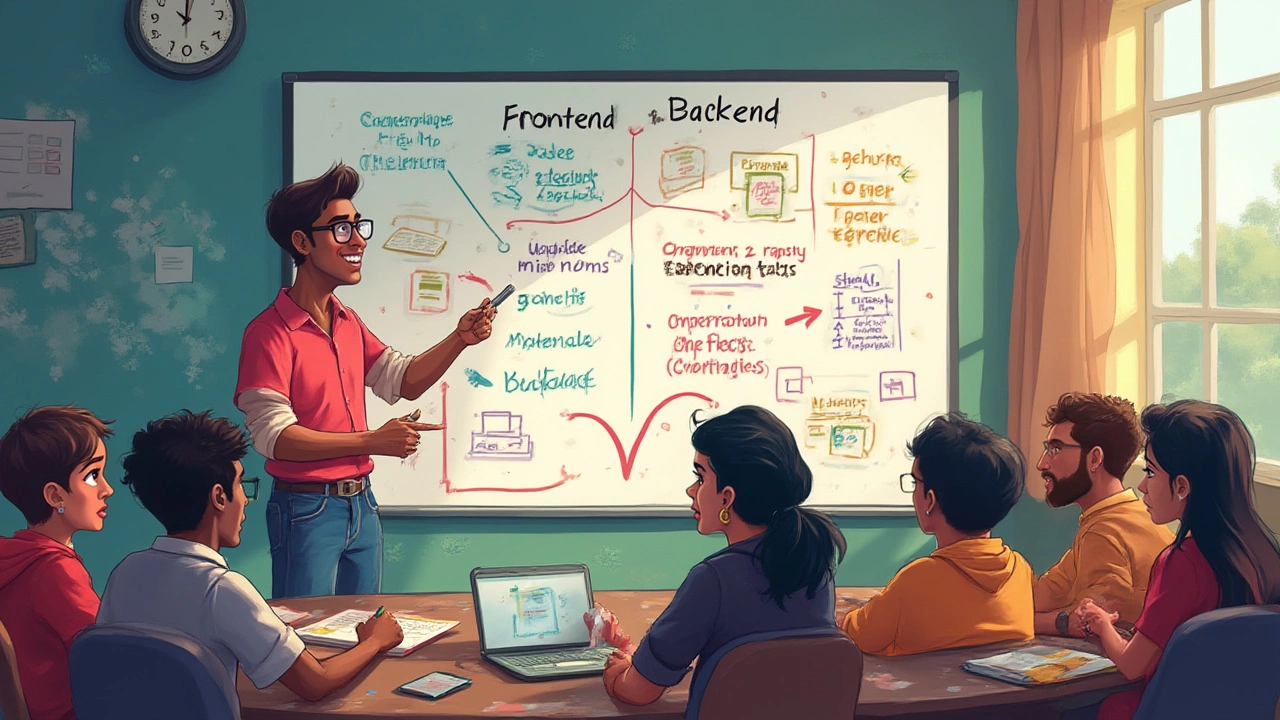Backend vs Frontend: Which Side of Web Development Is Easier?
“Backend or frontend—which is easier?” People ask this all the time, almost like it’s a one-or-the-other question with a clear answer. But the reality? It’s a debate that won’t die, and for good reason. Stack Overflow’s 2024 developer survey showed that half of new developers rated frontend as harder because of how fast it changes, while backend folks called their territory 'invisible but intimidating.' The lines keep blurring and opinions just get louder. So, is backend really easier than frontend? Or is it the other way around? Let’s jump straight into the heart of the matter.
What Makes Backend and Frontend Development So Different?
Let’s call it as it is. The tasks differ radically and so do the skills. Frontend is what users see and touch: all those buttons, forms, animations, and layouts. You use HTML, CSS, and JavaScript—sometimes lots more, like React, Vue, or Tailwind. The thing is, on the frontend, you learn fast that users have zero patience for broken buttons, out-of-place colors, or glitchy menus. You’re basically painting, but the canvas keeps moving and suddenly someone wants it to be a video. On top of that, there’s cross-browser madness. Want your site to look the same in Chrome, Safari, Edge, or that one ancient Android browser your boss still uses? Good luck. You’ll wrestle with bugs only to learn later that it’s not your code, it’s just Internet Explorer being, well, Internet Explorer.
The backend, on the other hand, is the logic behind the curtain. Here you’re working with databases, authentication, APIs, security, and server management. No one really “sees” it unless it’s broken—which means, if users notice your work, something’s wrong. You could be coding in Python, Node.js, Ruby, PHP, Go, or Java. Some frameworks—like Django or Express—make things move faster, but the core job remains: process data, handle business logic, store everything safely, and spit it back out when it’s needed. It’s less glamorous, sure, but backend is basically the reason the whole site works.
How about difficulty? Well, here’s a straightforward truth: frontend gets all the heat for being “easy,” but nailing it takes a weird mix of art and code. Backend is “logical,” but the complexity explodes with scale. A simple database isn’t scary—but try building a secure, scalable app handling a million records an hour. Frontend requires you to care about every pixel. Backend demands you care about every query, every line of security, every tiny risk that could lose the company’s data. Neither job is a walk in the park.
Now, look at how the job market divides these roles. According to LinkedIn’s 2025 tech report, about 70% of junior dev roles are in frontend, but backend salaries still average 20% higher in the US. Why? Backend requires mastering topics people find dry: SQL queries, data modeling, cryptography, and API design. That extra pay is really for handling the boring, stressful, and risky parts most others try to dodge.
Ever seen someone panic because their CSS grid won’t line up? Compare that to someone debugging a production server outage at 2 AM—both stressful, in radically different ways. Here’s a glance at common daily tools:
| Frontend Tools | Backend Tools |
|---|---|
| React, Vue, Angular | Express.js, Django, Spring Boot |
| HTML, CSS, JavaScript | Python, Node.js, Java, PHP |
| Chrome DevTools | Postman, Docker |
| Figma, Sketch | MySQL, MongoDB, Redis |
So, are backend and frontend really miles apart in difficulty? Only if you stick to the surface. Dig deeper and both can be a maze, just with different monsters around each corner.

Why Some Say Backend Is Easier—and Why Others Seriously Disagree
There’s this old stereotype that backend is easier because you “don’t deal with browsers” and “logic is universal.” That’s way oversimplified. Sure, you skip the CSS chaos and cross-browser thing, and you don’t have to obsess over pixel-perfect design. But you pick up a bunch of new problems. Security is top of the list: leaks and hacks are brutal and way more likely. Mess up one SQL query, you might lose a week of data. Leave out sanitizing user input? Suddenly, your platform is on the wrong end of a data breach. According to OWASP’s 2025 list, eight out of their top ten web security risks are backend-related.
Let’s talk scale. A frontend dev rarely has to stress about what happens when 10,000 people hit “refresh” at once. The backend dev does—because that can crash the service in seconds. Suddenly you’re sorting out caching, load balancing, and failover strategies. Know what a deadlock in PostgreSQL looks like? You will, and it won’t be fun the first time.
But if you ask around, frontend scares people for totally different reasons—the pace. JavaScript frameworks change almost monthly. React went from class components to hooks in a flash; Vue updated its syntax twice in a couple of years. If you step away for a year, your skills are out of date. On backend, yes, new stuff appears, but ‘vanilla’ skills in SQL, HTTP, and how servers work never get old. That’s probably why you hear backend folks say, “It’s steadier, less wild west.”
Another curveball is debugging. Frontend bugs can sometimes be seen and replicated easily—a broken button, misaligned text, a modal that won’t open. Backend bugs? Sometimes you only find out when a critical function fails at 3 AM, and you can’t see anything except logs. Can you trace a user’s data through ten microservices with three database calls and two third-party APIs? Welcome to backend hell. But, if you love puzzles, this is pure fun.
The skills needed for backend can scare people off: algorithms, data structures, logic, networking. Frontend has its own mountain: color theory, accessibility, responsive layouts, UI/UX. If you think backend is just for “math people,” you’ll be surprised how creative it gets—optimizing queries, designing APIs people actually like, or planning database schemas that won’t collapse as the app grows.
Let’s settle one thing: neither side is “easy” for most people, just “easier” based on what fits your brain. Enjoy instant feedback and visual progress? Frontend will feel better. Like untangling big messy systems? Backend’s your playground. And lots of jobs now expect you to know both. Full stack isn’t a unicorn role—it’s growing fast, and US job site Indeed reported a 30% rise in “full stack” positions in just under two years. That means employers want flexible devs, not just a CSS or database wizard.
Here’s a quick rundown of what people actually mean by “easier”:
- Frontend: Fast setup, fun visuals, lots of instant feedback. But you can spend hours fixing layout bugs.
- Backend: Logical, build-once-and-it-runs, more stable tools. But tiny mistakes can crash the whole app, and learning never ends.
- Pace: Frontend tools change fast. Backend changes slowly, but the learning curve is steep.
And if you like numbers, here’s one from a 2025 CodeinWorker poll: 54% of entry-level developers got their first paid freelance jobs in frontend, but 92% of backend jobs paid higher within their first year. Take what you will from that—just know “easier” often means “easier to get started,” not “easier to master.”

Tips for Picking Your Path (and Getting Good at Either)
If you’re wondering which to choose, think about how you work best. Are you obsessed with how things look and feel? Do you get annoyed when a button is a pixel off or a menu stutters on scroll? Dive into frontend. It rewards obsessive testers, creative minds, and people who follow trends. Read MDN docs all the time, learn Chrome DevTools shortcuts, and always check your code on an old phone. If you want extra power, check out React, Vue, or Svelte—these frameworks make big projects possible. Most importantly, don’t skip the basics (HTML, CSS, and JavaScript)—frameworks come and go, but those stick around.
If you love building systems no one ever sees, if you’re weirdly satisfied when abstract things just “work,” and if you prefer logical puzzles, try backend. Practice writing REST APIs, play with authentication, spin up a little server with Node.js or Flask. Use Docker—yes, it’s confusing at first, but almost every 2025 job post asks for it. Don’t sleep on databases; SQL is still everywhere, and NoSQL (like MongoDB) is great for side projects. Security matters too, so spend time learning about injection attacks and rate-limiting. Want to stand out faster? Master the art of documentation—backend jobs love people who can explain their logic.
Whatever side you pick, join communities—Discord, Reddit, Twitter (now called X, but nobody calls it that). Ask questions and share your progress, but don’t get lost in endless tutorials. Build stuff, even if it’s simple. A to-do list or a clone of a famous site does more for your career than watching five hours of another YouTube series. And speaking of YouTube, find a dev you vibe with—there are dozens giving real advice, not just flashy tricks.
Some advice straight from hiring managers in 2025: Employers check Github first. They like seeing finished projects, not unfinished ideas. Clean code and clear commits make you stand out. If you’re aiming for frontend, show off your designs—publish them on CodePen or similar sites. For backend, write detailed READMEs and include setup instructions. And if you want to go full stack, create a full app with a front, a back, and a database. That’s a golden ticket.
Don’t stress about chasing the “easy” option. Every developer has moments when they want to throw the laptop out the window—frontend or backend. Go with what keeps you challenged but not overwhelmed. Your first project will always be the hardest, and it gets better as you find your groove.
If you’re still stuck, ask real devs. Hit up forums or find someone local. Better yet, build a tiny app that does both—a frontend and a backend talking to each other. You’ll get a taste, and the answer will get clearer. Most importantly, ignore anyone who says “this side is easier” unless they’ve done both. Only you will know which puzzle you want to solve every day—and that’s the decision that sticks.





